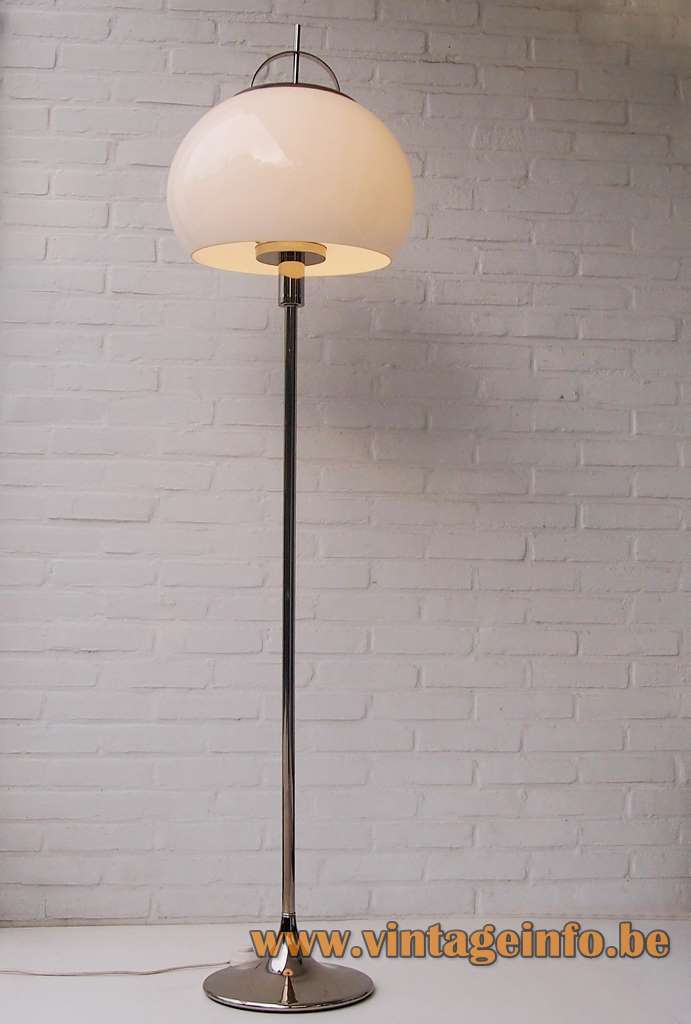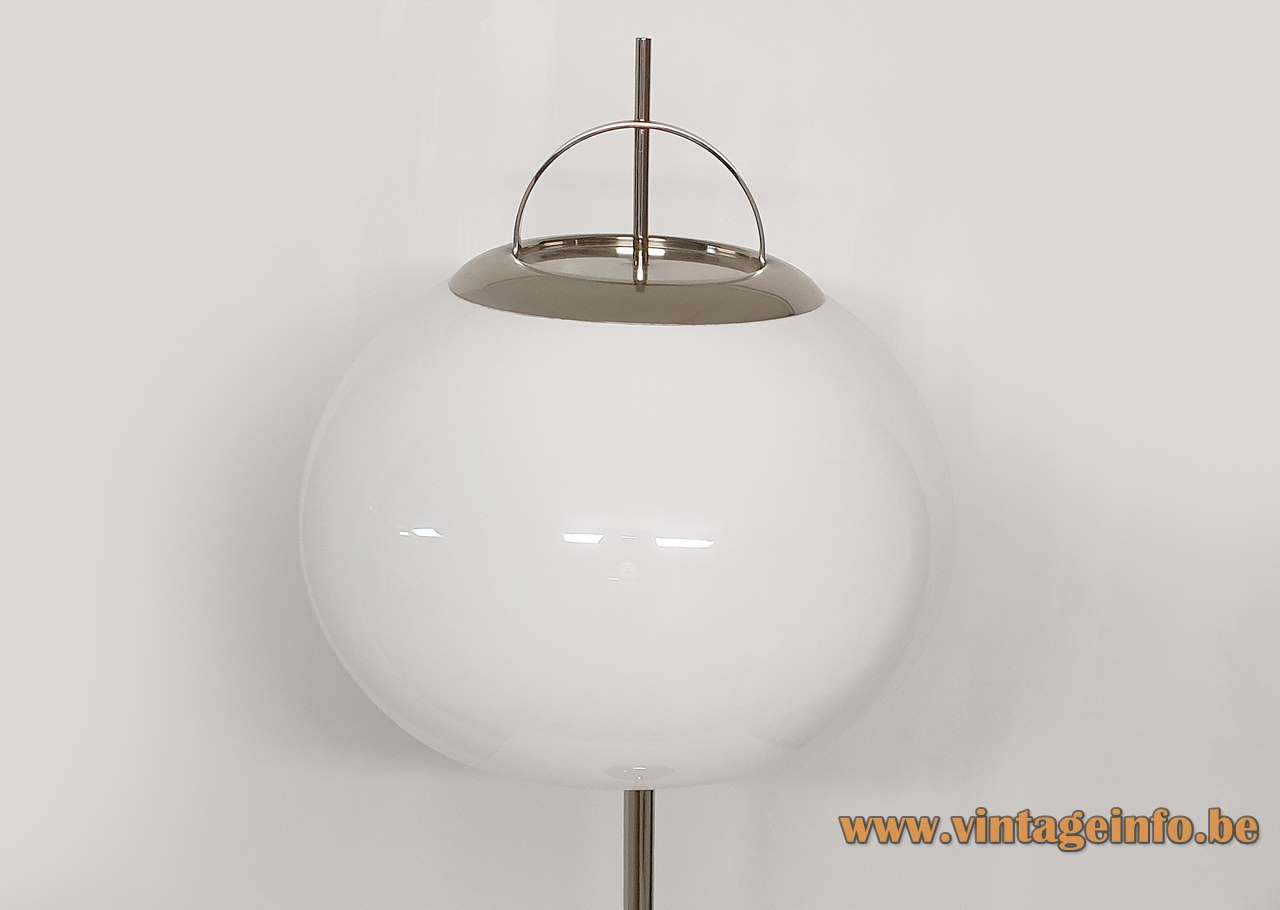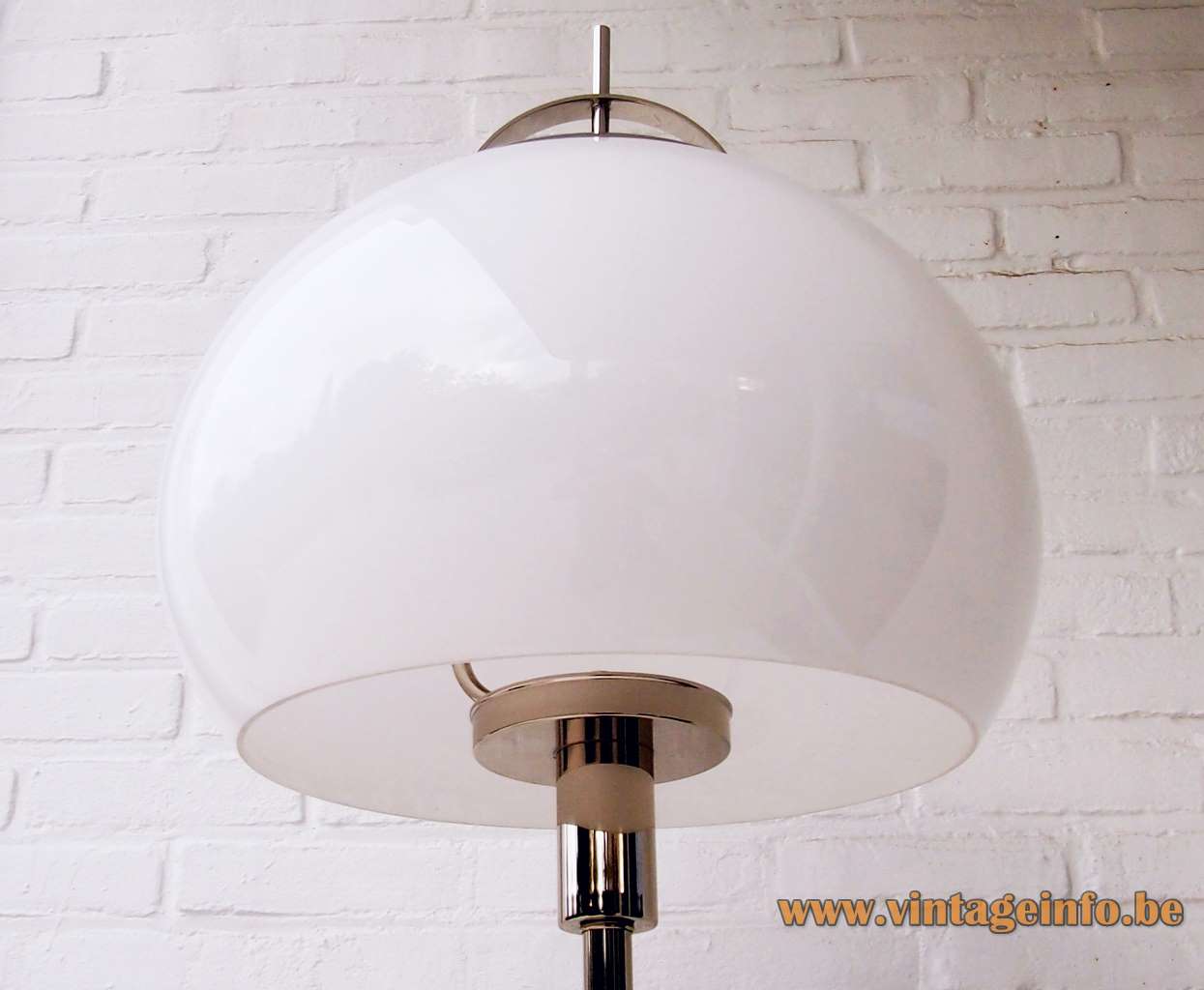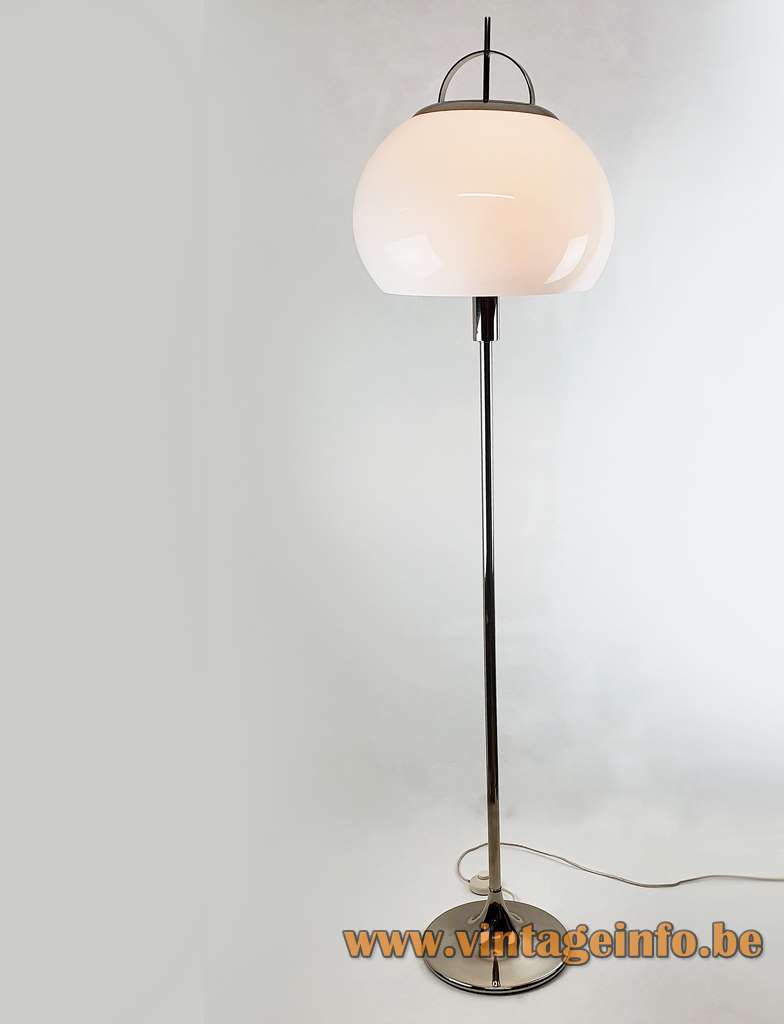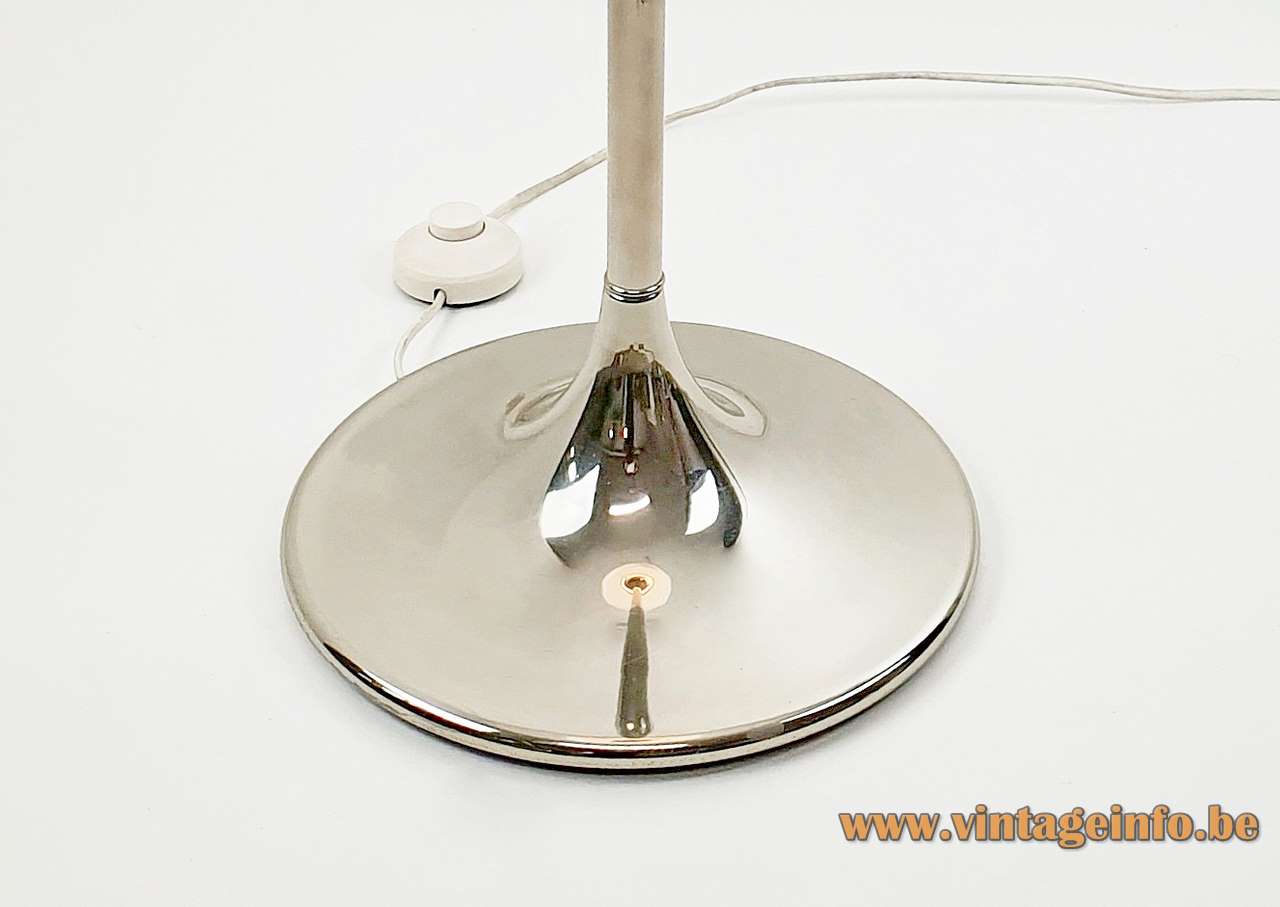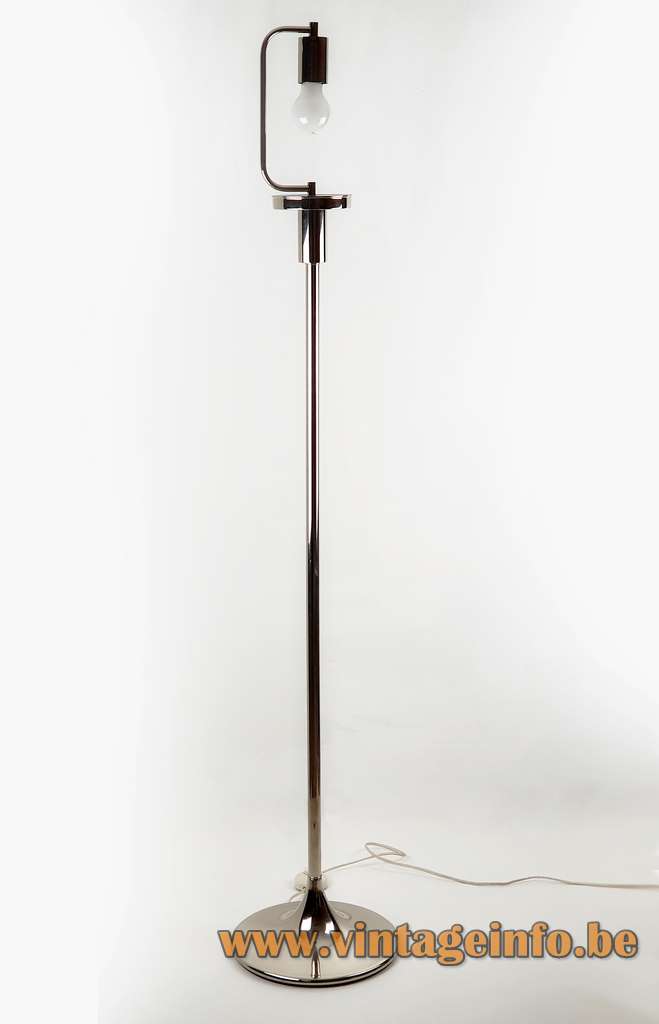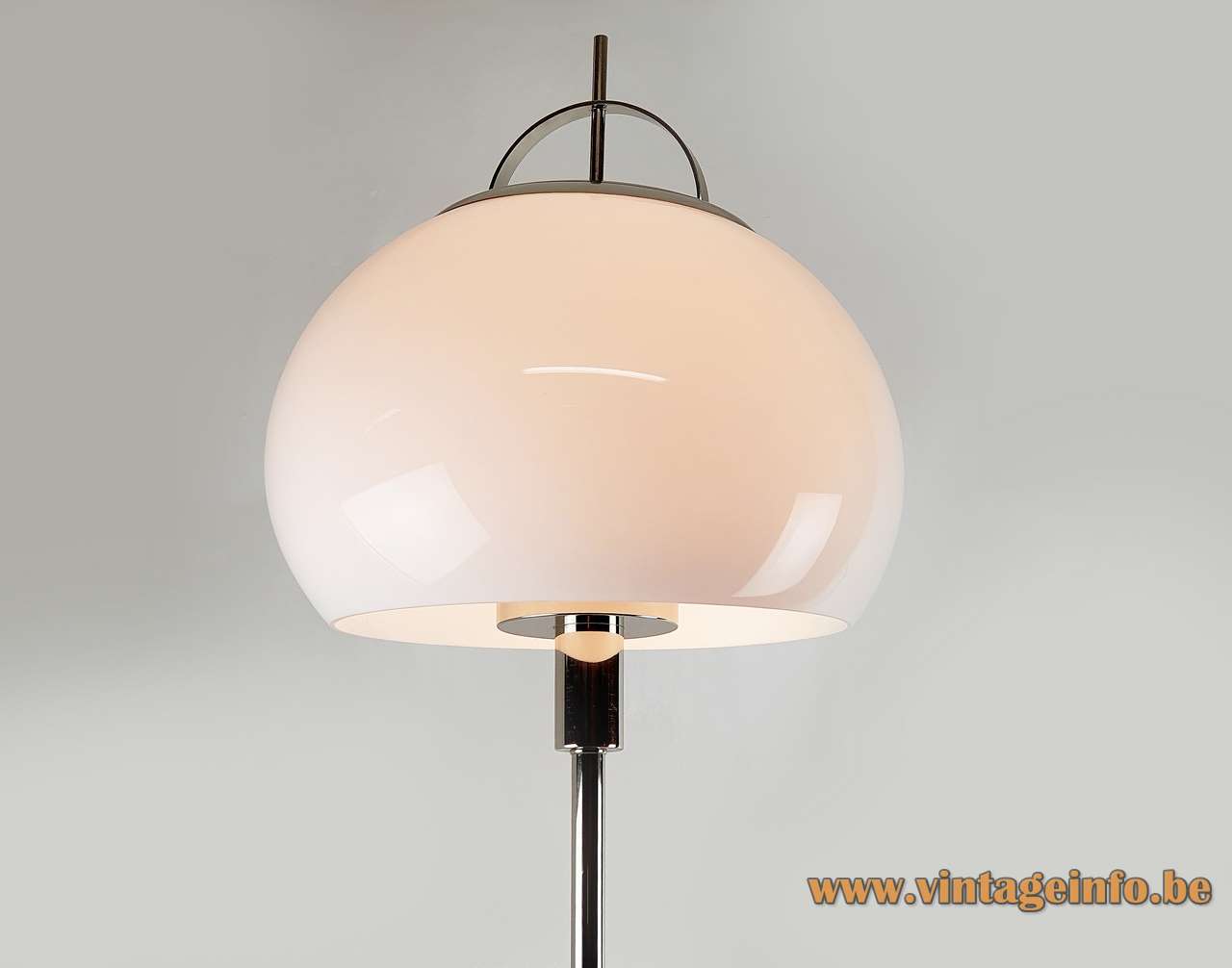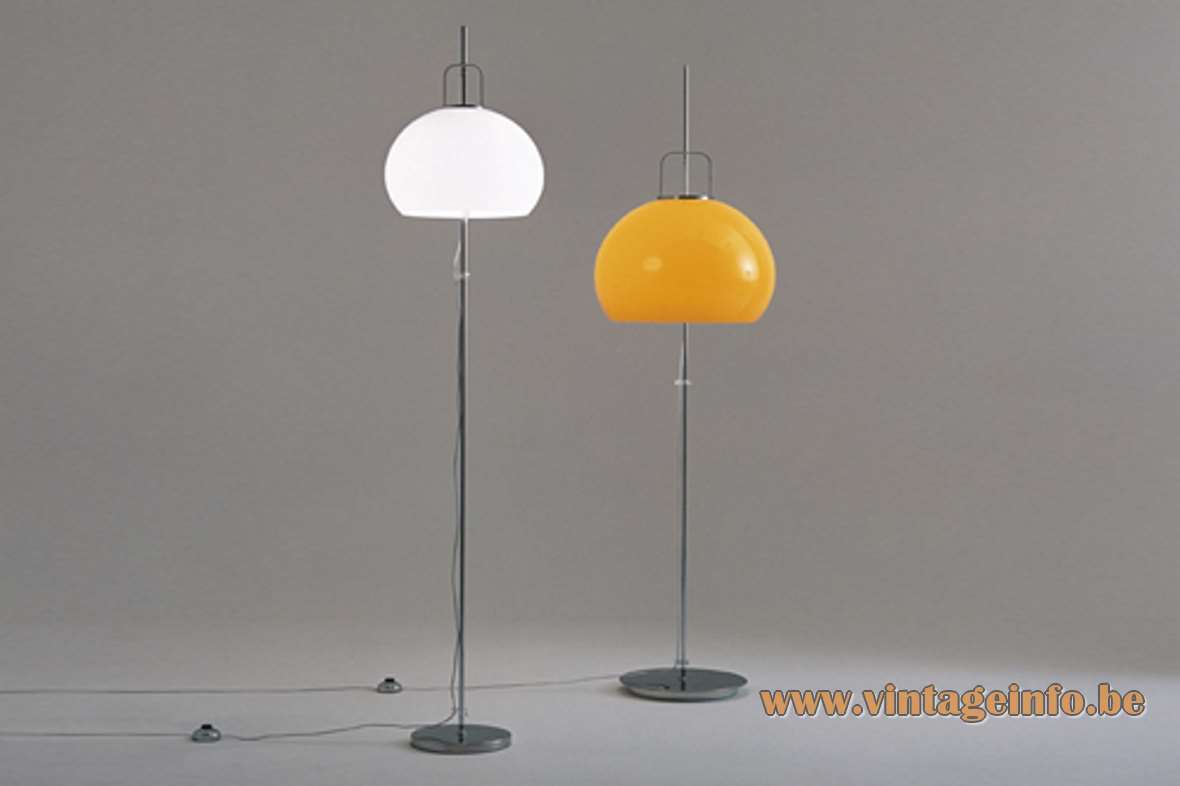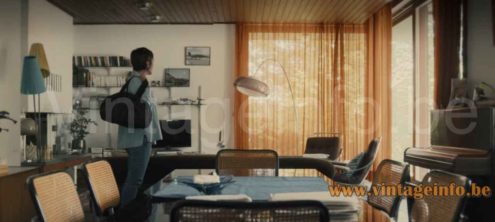Harvey Guzzini Lucerna floor lamps – catalogue picture
Lamps In The Movies
The table lamp version of this floor lamp appears in the 2016 – 2023 Belgian TV series Ennemi Public (Public Enemy). Starring: Stéphanie Blanchoud, Jean-Jacques Rausin and Clément Manuel. The table lamp is on the left in this picture. The arc floor lamp is also a lamp made by S.A. Boulanger. The other floor lamp on the left is probably a German lamp.
VLM Components
All the electric parts of this lamp were made in the 1970s by VLM Components from Buccinasco, near Milan in Italy. The company is famous for the switches designed by Achille Castiglioni.
VLM Components is part of the Relco Group, founded in 1967. Today they are the owners of the brands Relco, Leuci, Relco Lighting, VLM and Segno.
Acrylic: often named by its commercial name: Perspex, Plexiglas, Crylux, Acrylite, Lucite, is a thermoplastic.
Many thanks to Ger for the beautiful pictures.
Links (external links open in a new window)
Massive – Wikipedia (in Dutch)
Ennemi Public (2016 – 2023) TV Series – IMDb
Vintageinfo
Guzzini Lucerna Style Floor Lamp
Materials: Round chromed metal (iron) base. Chrome rods and parts. Adjustable white acrylic mushroom globe lampshade. Aluminium lid and “handle” on top. Some metal parts. Bakelite E27 socket.
Height: 165 cm / 64.96”
Lampshade: ∅ 40 cm / 15.74”
Base: ∅ 30 cm / 11.81”
Electricity: 1 bulb E27, 1 x 60 watt maximum, 110/220 volt.
Any type of light bulb can be used, not a specific one preferred.
Period: 1970s – Mid-Century Modern.
Designer: To be appraised.
Manufacturer: Société Anonyme Boulanger, Anderlecht, Belgium.
Other versions: This Harvey Guzzini Lucerna style floor lamp exists in several colours. It also exists with a flat chrome base. Also table lamps and pendant lamps exists.
This floor lamp and also the table and pendant lamp were also sold by Massive, the other famous Belgian company. You can find the with both labels (or without).
This lamp is almost a copy of the Lucerna floor lamp made by Harvey Guzzini since 1966 and designed by the internal design team Ufficio tecnico interno. The Lucerna was produced until 1977.
The Lucerna floor lamp was made in two versions and many colours. Also a pendant lamp and table lamp were made. Several other lamps with the same base and lampshades with this bow on top exists, but they all have a different name.
Also the German Brilliant Leuchten made their version of this floor lamp. It has chrome tubes on top instead of slats and a flat base with a rounded edge. Another Belgian company, Geve, produced a floor lamp with also a chrome rim below.
S.A. Boulanger
S.A. Boulanger was founded in Anderlecht, Belgium in 1945. The company is famous for the large amount of lights it produced that were designed by Gaetano Sciolari. At some point in the 1980s the company changed their name in Les Ateliers Boulanger NV.
It has long been thought that they were two different companies, but that is because a trader from Liège, Belgium persisted that the lamps came from Herstal, near Liège.
In 1996 the company had 11 employees. The firm moved in 1998 to the Martelarenlaan 155 in 3010 Kessel-Lo, near Leuven. In the period 1995 – 2001 Jean-Philippe Spalart was the CEO. He did a feasibility study for the transfer of the company to China, Eastern Europe and Africa. Relocation of the manufacture in Zimbabwe.
Boulanger was specialised in metal processing and manufacturers high-end lamps and lighting fixtures. Les Ateliers Boulanger ended business in 2006.
Massive & Boulanger
Massive sold several Boulanger models over the years. The only difference is the typical Massive canopy/ceiling cap and some other parts.
Old text from the 1990s
“Boulanger sells mainly in the high-end lighting markets in Belgium, Germany and Luxembourg. The growing sales in the US and in South Africa are of growing importance to the company. Due to the highly competitive market, having product with a high added value is very important. The intelligent lamp is an important advantage, compared to our competitors, and will increase our market share in an important way.
The most important local competitors are Massive, a Belgian company, market leader in Europe (turnover of 100 MEUR), Deknudt at Deerlijk (turnover 2.5 MEUR) and some 10 other Belgian competitors of its own size. There is important competition from southern European and Asian competitors. The market share of Boulanger is only a few percent of the share of the Belgian companies. It is a small company with a turnover of about 300 k EURO.”
“Most Boulanger lamps are low voltage and halogen lamps (220V up to 300W or 12V up to 50W).
The products are sold to retail shops. In Belgium, about 300 retail shops sell its products. There are around 40 retail shops abroad: Luxembourg, Germany, France and South Africa.”
Massive
Origins and Early Growth (1926–1970s)
Massive started in 1926, when Pieter-Jozef De Jaeck founded a bronze foundry in Wilrijk, near Antwerp, Belgium. Initially, the company crafted traditional bronze items such as candlesticks, crucifixes, and chandeliers in-house using established casting methods.
However, as the market evolved during the 1930s and 1940s, Massive quickly adapted to meet changing consumer needs. Therefore, the company gradually introduced more functional lighting products for households. After World War II, electric lighting became more popular across Europe.
Consequently, Massive began combining classic design with modern electrical technology. This strategic shift enabled the brand to reach new customers and grow steadily.
By the 1950s, Massive had earned a solid reputation across Belgium. Its lighting fixtures – often inspired by mid-century trends – were both affordable and practical. Moreover, they were widely available in hardware and furniture stores. As a result, they became a staple in many homes.
In the 1960s, Eddy De Jaeck, the founder’s son, joined the company. He introduced semi-industrial production techniques and optimized logistics. As a result, Massive shifted from a craft-based workshop to a mass production business. This major change laid the groundwork for international expansion.
Design Approach and Product Strategy
Massive became known for producing lighting in the style of more exclusive brands. While they didn’t make direct copies, many of their designs were clearly “inspired” by well-known models. Nevertheless, the company also released some original highlights that stood out in their own right.
In addition to their own production, Massive distributed a significant number of lamps made by other manufacturers. This strategy was not unusual at the time. Many lighting companies across Europe followed the same practice to broaden their product range and appeal to a wider market.
International Expansion and Market Leadership (1970s–2000s)
During the 1970s, Massive expanded rapidly. With Eddy De Jaeck at the helm, and later his sons Piet and Jan De Jaeck, the company grew into a multinational enterprise. To stay affordable and increase volume, Massive moved production to Eastern Europe. Later, it extended manufacturing to China. This deliberate strategy helped the brand stay competitive in a changing market.
By the 1980s, Massive had become one of the top lighting brands in Europe. Its catalog included thousands of options for both indoor and outdoor use. Furthermore, the brand balanced style, affordability, and reliability. Because of this, it gained popularity in both Western and Eastern Europe.
In the Netherlands, Massive began operations in 1962. In addition, the company opened Massive Gorinchem in 1969. This location served as the Dutch headquarters for more than 40 years. Eventually, in late 2012, it relocated to Eindhoven.
Ownership Changes and the Philips Takeover (2002–2010)
In 2002, the De Jaeck family sold Massive to CVC Capital Partners for about €250 million. This move transformed the company into part of the new group, Partners in Lighting International (PLI).
Over the next years, PLI expanded quickly. For example, in 2005, the group acquired Modular Lighting Instruments. Then, in 2006, it added Trio Leuchten from Germany. As a result, PLI marketed over 10,000 products under brands like Massive, Lirio, Trio, Aqua, and Cucina.
The company grew further by employing about 5,000 people and operating in more than 70 countries. In 2007, Royal Philips Electronics announced plans to acquire PLI. The deal closed in 2008, which strengthened Philips‘ position in the European home lighting market.
Soon afterward, Philips rebranded all Massive stores in Belgium as Light Gallery. By 2014, the Massive name had vanished from packaging and store displays alike.
The End of an Era and the Move to Signify (2010–2024)
After the acquisition, Massive‘s visibility declined steadily. In 2016, Philips Lighting became a separate, publicly traded company. Then, in 2018, the company rebranded as Signify. This new identity marked a fresh focus on smart and connected lighting.
Eventually, in April 2024, Signify shut down the Light Gallery website and redirected all content to its main platform. Although the Massive name no longer appears in stores, its legacy lives on. Millions of homes throughout Europe still feature its recognizable and timeless lighting designs.
